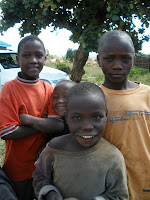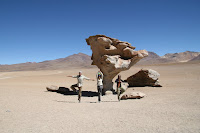This is a hongera light:
 We have one on every wall of our living room. We’re pretty sure the house plans only included the one normal light bulb hanging from a cord in the middle of the ceiling, but somehow we also ended up with the hongera lights. When turned on, they alternately flash lavender, turquoise, purple, yellow, red, and green. At night our living room looks like an empty discotheque.
We have one on every wall of our living room. We’re pretty sure the house plans only included the one normal light bulb hanging from a cord in the middle of the ceiling, but somehow we also ended up with the hongera lights. When turned on, they alternately flash lavender, turquoise, purple, yellow, red, and green. At night our living room looks like an empty discotheque.
Mind you, the cabinet doors don’t close, the bathroom light switch turns on the light in the room next to it, and the back door was installed with a 4-inch gap at the bottom – but the hongera lights work perfectly. Priorities, priorities.
Mid-July marked the 12th week of our Savings Clubs. Members can now apply for loans from their group’s savings. The groups whose members have met their savings goal every week during the 12 weeks qualify to have Nuru match their loan amount, doubling the principal they have to loan from. This is Mkombozi, one of our best groups, signing their loan contracts.

I’m realizing how much infrastructure I took for granted when I was working with Pro Mujer. All of the paperwork, accounting, and information management systems were in place. Now I am building all those elements from scratch, trying to figure out what applies or is necessary. Thus far, Savings Club deposits are issued a receipt which is then recorded in a journal. The addition used in said journal is questionable, as is the accuracy of the group name under which the transaction was recorded (does the deposit recorded under “Vision Group” belong to Vision Farming or Nyaihungurumo Vision Group??). Apparently, receipts weren’t issued for withdrawals so we have no formal record of these, just notes scribbled in the margins of the Office Manager’s notebook. The loan contracts we’re using were written the night before we issued the loans.
The beauty of Savings Clubs is that many of the management tasks (such as how much each member contributes and when) are the responsibility of the group representatives. But we are going to need to establish more formal and detailed procedures for the program. It feels inappropriate to push for electronic record keeping when the Nuru office in Nyametaburo is operating off a solar panel and gets invaded periodically by chickens or goats, but we’re growing so quickly that the volume and complexity of transactions is going to require it soon. Besides, Nuru is responsible for this money and we take that seriously. A lot of our members have never saved before, and we owe it to them to have every detail in place to keep it safe. So I can be as OCD as I want! Perfect.
 www.NuruInternational.org
www.NuruInternational.org

















 We continue on to my anxiously-planned Tour de Sucre. Sucre graciously humors me with the impossibly blue, blue skies and dazzling sunshine I had hoped to present the White City in. Saturday is Día de los Niños y Niñas so we go to the party at my orphanage. I am “madrina” of the cake, which involves balancing a drum-sized cake on my knees while at the mercy of the driving of a Bolivian taxista. Absolutely terrifying. Bolivians always march around carrying entire cakes from the market on a skinny piece of styrofoam. They make it look so easy.
We continue on to my anxiously-planned Tour de Sucre. Sucre graciously humors me with the impossibly blue, blue skies and dazzling sunshine I had hoped to present the White City in. Saturday is Día de los Niños y Niñas so we go to the party at my orphanage. I am “madrina” of the cake, which involves balancing a drum-sized cake on my knees while at the mercy of the driving of a Bolivian taxista. Absolutely terrifying. Bolivians always march around carrying entire cakes from the market on a skinny piece of styrofoam. They make it look so easy. 


 It is blinding and immense, not soft like the snow it appears to be, and etched into an eccentric patchwork quilt by the ridges left behind by water that rises to the surface. It doesn’t crumble easily; there are no footprints. The salt burns my chin where I’ve been resting my head on the ground to take perspective pictures of us popping out of wine bottles and hugging giant iPods. The trip ends in the train graveyard, an unlikely (read: only in Bolivia) tourist attraction of silent giants, after 3 days of car games and an unhealthy number of lollipops.
It is blinding and immense, not soft like the snow it appears to be, and etched into an eccentric patchwork quilt by the ridges left behind by water that rises to the surface. It doesn’t crumble easily; there are no footprints. The salt burns my chin where I’ve been resting my head on the ground to take perspective pictures of us popping out of wine bottles and hugging giant iPods. The trip ends in the train graveyard, an unlikely (read: only in Bolivia) tourist attraction of silent giants, after 3 days of car games and an unhealthy number of lollipops.


